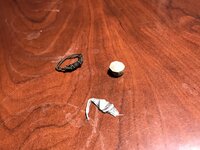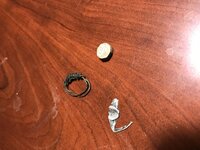vferrari
Silver Member
- Jul 19, 2015
- 4,910
- 8,377
- Detector(s) used
- XP Deus with HF/x35 Coils and Mi6 Pinpointer/ML Equinox 600/800/ML Tarsacci MDT 8000 GPX 4800/Garrett ATX/Fisher F75 DST/Tek G2+/Delta/Whites MXT/Nokta Simplex/Garrett Carrot
- Primary Interest:
- All Treasure Hunting
Short answer: Disc 10 (with Iron Volume = 0) is not the same as Notch 0 - 10 with no Disc (there is no sense in notching 0 -10 if you have Disc set to 10 but in that case, I guess it would be the same as iron volume of 0). With no discrimination set, then the Iron Volume setting does not matter.
Setting discrimination at 10 and setting iron volume at 0 is not exactly the same as Notching 0-10 (with disc off) because the notch is just an audio filter whereas discrimination affects the way the ferrous and non-ferrous signals are processed. Discriminating out ferrous at 0 - 10 may enable the Deus to better process some non-ferrous that may be in the vicinity of the ferrous target that is getting discriminated out whereas simply notching 0 - 10 may mean that the ferrous signal may pull down the non-ferrous signal Target ID even is the ferrous is not audible due to the notch. Too much Disc is a bad thing because it then starts adversely affecting the non-ferrous targets such that you might start suffering detection depth issues. Again the iron volume setting should not have any affect on detection depth other than you may hear simultaneous iron grunts along with the non-ferrous signal in the headphones.
Setting discrimination at 10 and setting iron volume at 0 is not exactly the same as Notching 0-10 (with disc off) because the notch is just an audio filter whereas discrimination affects the way the ferrous and non-ferrous signals are processed. Discriminating out ferrous at 0 - 10 may enable the Deus to better process some non-ferrous that may be in the vicinity of the ferrous target that is getting discriminated out whereas simply notching 0 - 10 may mean that the ferrous signal may pull down the non-ferrous signal Target ID even is the ferrous is not audible due to the notch. Too much Disc is a bad thing because it then starts adversely affecting the non-ferrous targets such that you might start suffering detection depth issues. Again the iron volume setting should not have any affect on detection depth other than you may hear simultaneous iron grunts along with the non-ferrous signal in the headphones.







